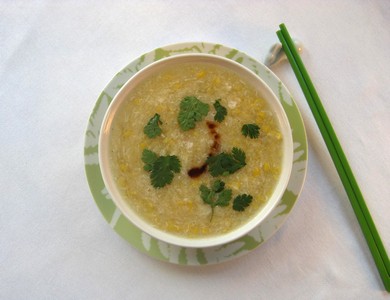Fred Schneiter moved to Hong Kong in the 1960s and wasted no time in getting to know the food. Here’s a story and a recipe for Chinese broccoli with oyster sauce from his new book, The Taste of Old Hong Kong.
If unaccustomed to chopsticks you’ll find the going easier—in initial encounters—simply by maintaining an affirmative attitude. Dismiss any thought that chopsticks are an ancient form of torture, invented to intimidate and frustrate fumbling foreign fingers. The secret is to relax and to keep in mind that Chinese also drop greasy things on the tablecloth and sometimes even on other people . . . and it isn’t a big deal. It happens.
Lunching on Hong Kong’s “Food Street” in Causeway Bay, a Cantonese lady beside me, at our tiny shared table, casually chopsticked a pork chop from her bowl of noodle soup.
Taking a dainty nibble, gravity suddenly prevailed. In an instant the chop plopped into her bowl, launching half her soup directly into my lap. The poor young thing was terribly embarrassed despite my assurance that it was OK. These things happen. Even to Chinese.
Then there was the Hong Kong Broccoli Incident which occurred while hosting a delegation of old friends from China’s Grain Bureau. Midway through the dinner we were served a steamy platter of slender, leafy, oyster-sauced Chinese broccoli. In the polite gesture of giving face to a dinner companion, the delegation leader, a particularly close family friend, was in the process of putting broccoli on my plate when her smile suddenly vanished as the slippery stuff started to slide off her chopsticks. She tried to catch the little varmint but, misjudging the thrust, catapulted the goopy glob straight into my tie. She managed just one or two tentative little embarrassed giggles before she and the entire table doubled over in gleeful guffaws as the gooey vegetable trailed a slow slimy slalom down the entire length of the tie.
Not only did it demonstrate what a fun food broccoli could be, it illustrated the wisdom of the old proverb, “When working together, laugh together.” Had this simply been one of those ubiquitous run-of the-mill Chinese business dinners, rather than a gathering of old friends, it could have proven a disaster.
Slapstick scenarios aside, this is a tasty and easy dish but if someone tries to put some on your plate, watch out. . . .
CHINESE BROCCOLI IN OYSTER SAUCE
serves 2 to 4
Ingredients
1 pound Chinese broccoli
¼ teaspoon salt
¾ tablespoon peanut oil
Sauce
3 tablespoons Chinese oyster sauce
½ teaspoon sesame oil
½ teaspoon peanut oil
1 teaspoon fresh ginger, peeled and minced
Cut off and discard leggy bottom part of broccoli stalks. Remove and discard any tougher large leaves, leaving intact the more tender smaller ones. Peel lower section of stalks below the leaves. Rinse broccoli well under cold running water. Shake off excess water. In a large pot, bring 3 quarts of water to a rolling boil and add the salt and peanut oil. Meanwhile, in a small saucepan, combine oyster sauce, sesame oil, peanut oil and ginger. Stir a few times, cover and bring to a low simmer for 30 seconds and set sauce aside. Add broccoli to the boiling water and when water returns to a boil, cover and cook 5 to 7 minutes, stirring occasionally. Doneness may be checked by chilling a piece and biting into it. The more fresh and tender the broccoli, the less cooking time is required. Remove broccoli from boiling water while it retains its color and is tender, yet crisp. Drain well for a few minutes in a colander, shaking off and discarding excess liquid. Place broccoli in a large bowl, pour sauce evenly over it and toss gently to mix. Arrange broccoli on serving plate. May be served hot or at room temperature with heated sauce.
Tips—Serving broccoli at room temperature frees you up for other last-minute details at the stove. In this case, set the cooked broccoli aside for up to 3 hours and add the sauce hot just before serving. Western broccoli works quite well, but Chinese broccoli is available in Asian markets and is worth seeking out for its distinctive taste and texture.






Leave A Comment